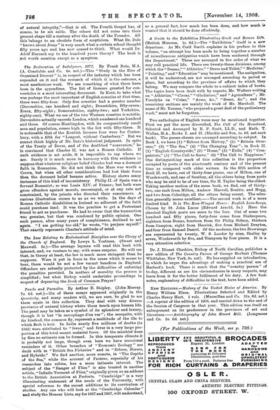Pearls and Parasites. By Arthur E. Shipley. (John Murray. 7s.
6d. net.)—Six of these essays appeared originally in the Quarterly, and many readers will, we are sure, be glad to see them again in this collection. They deal with very diverse provinces of natural history whdre these touch upon human life. The pearl may be taken as a symbol of its splendour and luxury, though it is but "le sarcophage d'un ver " ; the mosquito, with its kindred, the common fly, represent a multitude of the ills to which flesh is heir. In India nearly five millions of deaths (in 1892) were attributed to " fever," and fever in a very large pro- portion of this total meant malarial fever. Of the mischief done by files no estimate can be formed. In this temperate climate it is probably not large, though even here we have occasional reminders of it. Other branches of " Economic Zoology " are dealt with in "British Sea Fisheries" and in "Zebras, Horses, and Hybrids." We find another, more remote, in "The Depths of the Sea," while the account of Pasteur, especially of his researches into rabies, has a more intimate interest. The subject of the " Danger of Flies " is also treated in another article, "Infinite Torment of Flies," originally given as an address to the British Association at Pretoria. "Cambridge" is a very illuminating statement of the needs of the University, with special reference to the recent additions to its curriculum of studies. Any one who will look at the "Cambridge Calendar" and study the Honour Lists, say for 1857 and 1907, will understand,
as a general fact, how mach has been done, and how much is wanted that it should be done effectively.










































 Previous page
Previous page